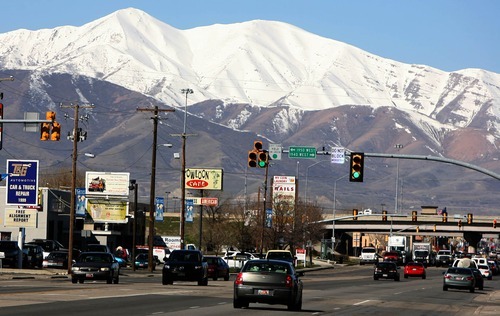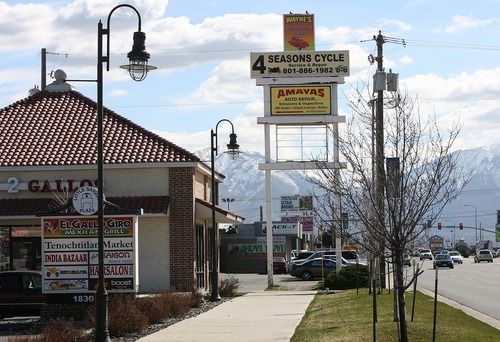This is an archived article that was published on sltrib.com in 2011, and information in the article may be outdated. It is provided only for personal research purposes and may not be reprinted.
Businesses with names like Tenochtitlan Market, India Bazaar and Pho Saigon Noodle House line 3500 South in West Valley City between Redwood Road and 2200 West. Colorful street banners celebrate the area as the "Granger Crossings Multicultural Marketplace."
They also may be signs of something unexpected that happened in the western valley over the past 10 years: The number of whites there decreased, while the number of minorities showed robust growth.
West Valley City, Taylorsville, Kearns and Magna had a combined loss of 14,856 whites in the past decade, according to a Salt Lake Tribune analysis of 2010 Census data. That is the equivalent of losing about half the population of Magna.
Meanwhile, the number of minorities — defined as anyone besides non-Latino whites — in the western valley grew by 42,460 people. That is the equivalent of adding more than the population of Kearns.
Those areas shifted from being a combined 25.7 percent minority in 2000 to 39.8 percent minority now. West Valley City itself is now 46.3 percent minority and is nearing "minority-majority" status. It already is minority-majority among children.
Western valley leaders offer many reasons behind the shift — including aging whites becoming "empty nesters" whose children move away; minorities being attracted to areas where other minorities already live; whites moving away from starter homes; and minorities moving there to be nearer to their jobs and churches.
On the side of the equation of increasing immigration by minorities, West Valley City Mayor Mike Winder says minorities may be attracted to the area "to be near minorities who already live there. It makes sense that you want to live near people who are like you."
He quotes a Census statistic that may show why many Polynesians have moved to his city. "Of all the cities in the nation with at least 100,000 residents, guess which one has the most Pacific islanders? It's Honolulu. Guess which is No. 2? West Valley City."
Winder also notes that the 2010 Census shows that "31 percent of West Valley City residents speak a language other than English at home." About a third of his city's residents are Latino.
Winder welcomes the diversity and says it strengthens the city and creates cross-cultural opportunities that can be fun. His city has operated the Utah Cultural Celebration Center for years, runs a program giving incentives to learn English, and is starting an initiative to encourage more minorities to get involved in city government where almost all officials still are white.
Rebecca Sanchez, director of Salt Lake County Mayor Peter Corroon's Office of Diversity, said some other reasons for minority immigration to the area are related to religion.
"Polynesians live on the west side because it is closer to their churches," she said.
Jobs are another factor. "Many industrial jobs are on the west side. Minorities who work in them want to be closer to work," Sanchez said, adding that "housing is cheaper on the west side, so you can get more house for the money."
So why is the number of whites dropping? Taylorsville Mayor Russ Wall says much of that may come from aging whites who have become "empty nesters."
"My wife and I are examples. We raised three kids in Taylorsville. But they grew up and have now moved to West Jordan, South Jordan and Bluffdale. Where we had five people in the house, now we only have two," Wall said.
At the same time that such white households decreased in size, he said, "We also find that sometimes Hispanics and Polynesians will have more than one family living in a home. A family that was designed to have five or six people may have eight to 10."
He adds that Taylorsville has little room to build new houses, so it may not attract as many whites as newer areas in the fast-growing southwest valley, such as South Jordan and Herriman.
University of Utah research economist Pam Perlich said the Census has not released data down to the household level yet that could help show precisely the extent of empty nesters and multigenerational families living together. But she said data so far suggest whites on the west side are aging, and as they move or die they have been replaced by younger minority families.
Alan Anderson, a longtime Kearns resident who is president and CEO of the ChamberWest chamber of commerce, says whites moving out may also be just part of a typical progression of people buying starter homes and later moving up to more expensive houses.
"Kearns is predominantly starter homes. A lot of people who move into the state — regardless of race or nationality — are looking for affordable homes. Many buy starter homes and later move on," he said, adding he constantly has seen that in his neighborhood.
He adds minorities often replace whites who move out of his area. He said changes have come so slowly that they often are not noticed. But one change of note, he said, is that a Christmas parade that his chamber sponsors recently began offering announcements in both Spanish and English.









